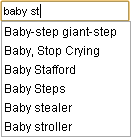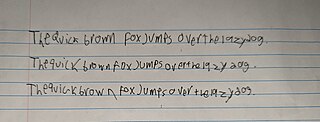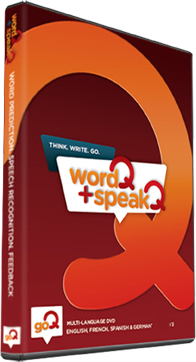
Assistive technology (AT) is a term for assistive, adaptive, and rehabilitative devices for people with disabilities and the elderly. Disabled people often have difficulty performing activities of daily living (ADLs) independently, or even with assistance. ADLs are self-care activities that include toileting, mobility (ambulation), eating, bathing, dressing, grooming, and personal device care. Assistive technology can ameliorate the effects of disabilities that limit the ability to perform ADLs. Assistive technology promotes greater independence by enabling people to perform tasks they were formerly unable to accomplish, or had great difficulty accomplishing, by providing enhancements to, or changing methods of interacting with, the technology needed to accomplish such tasks. For example, wheelchairs provide independent mobility for those who cannot walk, while assistive eating devices can enable people who cannot feed themselves to do so. Due to assistive technology, disabled people have an opportunity of a more positive and easygoing lifestyle, with an increase in "social participation", "security and control", and a greater chance to "reduce institutional costs without significantly increasing household expenses." In schools, assistive technology can be critical in allowing students with disabilities to access the general education curriculum. Students who experience challenges writing or keyboarding, for example, can use voice recognition software instead. Assistive technologies assist people who are recovering from strokes and people who have sustained injuries that affect their daily tasks.

Morse code is a method used in telecommunication to encode text characters as standardized sequences of two different signal durations, called dots and dashes, or dits and dahs. Morse code is named after Samuel Morse, one of the early developers of the system adopted for electrical telegraphy.

Microsoft Word is a word processor developed by Microsoft. It was first released on October 25, 1983, under the name Multi-Tool Word for Xenix systems. Subsequent versions were later written for several other platforms including: IBM PCs running DOS (1983), Apple Macintosh running the Classic Mac OS (1985), AT&T UNIX PC (1985), Atari ST (1988), OS/2 (1989), Microsoft Windows (1989), SCO Unix (1990), macOS (2001), Web browsers (2010), iOS (2014) and Android (2015). Using Wine, versions of Microsoft Word before 2013 can be run on Linux.

Optical character recognition or optical character reader (OCR) is the electronic or mechanical conversion of images of typed, handwritten or printed text into machine-encoded text, whether from a scanned document, a photo of a document, a scene photo or from subtitle text superimposed on an image.
A word salad is a "confused or unintelligible mixture of seemingly random words and phrases", most often used to describe a symptom of a neurological or mental disorder. The name schizophasia is used in particular to describe the confused language that may be evident in schizophrenia. The words may or may not be grammatically correct, but they are semantically confused to the point that the listener cannot extract any meaning from them. The term is often used in psychiatry as well as in theoretical linguistics to describe a type of grammatical acceptability judgement by native speakers, and in computer programming to describe textual randomization.

Autocomplete, or word completion, is a feature in which an application predicts the rest of a word a user is typing. In Android and iOS smartphones, this is called predictive text. In graphical user interfaces, users can typically press the tab key to accept a suggestion or the down arrow key to accept one of several.

Dysgraphia is a neurological disorder and learning disability that concerns impairments in written expression, which affects the ability to write, primarily handwriting, but also coherence. It is a specific learning disability (SLD) as well as a transcription disability, meaning that it is a writing disorder associated with impaired handwriting, orthographic coding and finger sequencing. It often overlaps with other learning disabilities and neurodevelopmental disorders such as speech impairment, attention deficit hyperactivity disorder (ADHD) or developmental coordination disorder (DCD).
Predictive text is an input technology used where one key or button represents many letters, such as on the physical numeric keypads of mobile phones and in accessibility technologies. Each key press results in a prediction rather than repeatedly sequencing through the same group of "letters" it represents, in the same, invariable order. Predictive text could allow for an entire word to be input by single keypress. Predictive text makes efficient use of fewer device keys to input writing into a text message, an e-mail, an address book, a calendar, and the like.

Augmentative and alternative communication (AAC) encompasses the communication methods used to supplement or replace speech or writing for those with impairments in the production or comprehension of spoken or written language. AAC is used by those with a wide range of speech and language impairments, including congenital impairments such as cerebral palsy, intellectual impairment and autism, and acquired conditions such as amyotrophic lateral sclerosis and Parkinson's disease. AAC can be a permanent addition to a person's communication or a temporary aid. Stephen Hawking, probably the best-known user of AAC, had amyotrophic lateral sclerosis, and communicated through a speech-generating device.

T9 is a predictive text technology for mobile phones, originally developed by Tegic Communications, now part of Nuance Communications. T9 stands for Text on 9 keys.

TED Notepad is freeware portable text editor software for Microsoft Windows, developed by Juraj Šimlovič since 2001, originally as a school project. It looks similar to Windows Notepad, but provides additional features, including experimental line completion and selection jumping.

A virtual keyboard is a software component that allows the input of characters without the need for physical keys. The interaction with a virtual keyboard happens mostly via a touchscreen interface, but can also take place in a different form when in virtual or augmented reality.
A speech-to-text reporter (STTR), also known as a captioner, is a person who listens to what is being said and inputs it, word for word, as properly written texts. Many captioners use tools which commonly converts verbally communicated information into written words to be composed as a text. The reproduced text can then be read by deaf or hard-of-hearing people, language learners, or people with auditory processing disabilities.

Speech-generating devices (SGDs), also known as voice output communication aids, are electronic augmentative and alternative communication (AAC) systems used to supplement or replace speech or writing for individuals with severe speech impairments, enabling them to verbally communicate. SGDs are important for people who have limited means of interacting verbally, as they allow individuals to become active participants in communication interactions. They are particularly helpful for patients with amyotrophic lateral sclerosis (ALS) but recently have been used for children with predicted speech deficiencies.
Article spinning is a writing technique used in search engine optimization (SEO), and other applications, which creates what deceitfully appears to be new content from what already exists. Content spinning works by replacing specific words, phrases, sentences, or even entire paragraphs with any number of alternate versions, in order to provide a slightly different variation with each spin — also known as Rogeting. This process can be completely automated or written manually as many times as needed. Early content produced through automated methods often resulted in articles which were hard or even impossible to read. However, as article-spinning techniques were refined they became more sophisticated, and can now result in readable articles which, upon cursory review, can appear original.
Technical translation is a type of specialized translation involving the translation of documents produced by technical writers, or more specifically, texts which relate to technological subject areas or texts which deal with the practical application of scientific and technological information. While the presence of specialized terminology is a feature of technical texts, specialized terminology alone is not sufficient for classifying a text as "technical" since numerous disciplines and subjects which are not "technical" possess what can be regarded as specialized terminology. Technical translation covers the translation of many kinds of specialized texts and requires a high level of subject knowledge and mastery of the relevant terminology and writing conventions.
Semantic compaction, (Minspeak), conceptually described as polysemic (multi-meaning) iconic encoding, is one of the three ways to represent language in Augmentative and alternative communication (AAC). It is a system utilized in AAC devices in which sequences of icons are combined in order to form a word or a phrase. The goal is to increase independent communication in individuals who cannot use speech. Minspeak is the only patented system for Semantic Compaction and is based on multi-meaning icons that code vocabulary in short sequences determined by rule-driven patterns. Minspeak has been used with both children and adults with various disabilities, including cerebral palsy, motor speech disorders, developmental disabilities, autism spectrum disorder, and adult onset disabilities such as Amyotrophic Lateral Sclerosis (ALS).

WordQ® is an assistive technology software developed by Quillsoft Ltd. and Holland Bloorview Kids Rehabilitation Hospital. WordQ's main purpose is helping individuals who struggle with reading and writing. Often that struggle is due to physical disability or neurodivergence such as Dyslexia or ADHD. WordQ uses intelligent word prediction to suggest words that the user is typing in as few as 1.3 keystrokes. This helps with spelling, and reduces the amount of physical movements a user has to make when typing. It also uses high-quality Acapela text-to-speech voices to read back text that the user has entered, allowing for proofreading and editing. WordQs speech recognition feature, SpeakQ®, is included in WordQ Desktop for Windows OS. It allows users to switch between speaking and typing while writing. WordQ Desktop is available for Windows and Mac OS, iWordQ is available for iPadOS, and WordQ Chrome for the Chrome browser is slated for release in January 2022.
Word recognition, according to Literacy Information and Communication System (LINCS) is "the ability of a reader to recognize written words correctly and virtually effortlessly". It is sometimes referred to as "isolated word recognition" because it involves a reader's ability to recognize words individually from a list without needing similar words for contextual help. LINCS continues to say that "rapid and effortless word recognition is the main component of fluent reading" and explains that these skills can be improved by "practic[ing] with flashcards, lists, and word grids".
The following outline is provided as an overview of and topical guide to natural-language processing:










